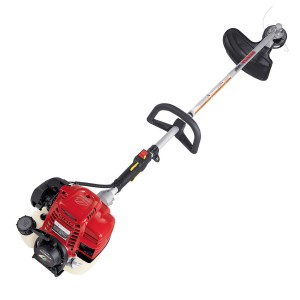 The HHT25S can be fitted with a trimmer head to make quick work of weeds or a blade for cutting down saplings and thick brush. All that power also means this trimmer can cause serious injury from flying debris and blade thrust, but these dangers can be minimized by using this equipment correctly.
The HHT25S can be fitted with a trimmer head to make quick work of weeds or a blade for cutting down saplings and thick brush. All that power also means this trimmer can cause serious injury from flying debris and blade thrust, but these dangers can be minimized by using this equipment correctly.
Staying Safe with the Correct Clothing
Always wear ANSI Z87.1 rated safety glasses when using this trimmer: the number one cause of injury when using trimmers is debris striking the eyes.
Noise from the engine can regularly exceed 85 db, which can cause permanent hearing damage over time. For this reason, it’s recommended that the operator wears hearing protection.
Wearing a long sleeve shirt, gloves, full length pants and boots can help reduce the impact of debris which means fewer, less severe injuries.
Always wear the included harness when trimming. It’s designed to keep the cutting head away from your body, reducing the chance of being cut by the blade or cutting line.
Controls
Choke lever: Located at the back of the engine above the gas cap. Set it to “CLOSED” when starting a cold engine and “OPEN” while operating or when starting a warm engine.
Priming bulb: Before starting, this bulb should be pushed until fuel can be seen in the clear fuel return line below it to ensure there is gasoline in the carburetor.
Ignition switch: Located on the back of the control grip, this switch must be set to “ON” for the engine to start. It can be turned off for emergency stops. Keep in mind that it can take several seconds for the blade or lines to stop spinning after the engine has been shut off.
Operator Presence Lever: Built into the back of the control grip, it must be held down for the throttle move. If the operator loses control, this will set the engine to idle automatically, disengaging the cutting head.
Throttle: The trigger at the front of the control grip controls engine speed. Hold it down for full throttle while cutting.
Reducing Debris Damage
Before working in an area, clear away any small objects that could be thrown including toys, glass, wire and other small objects. Always release the throttle before crossing gravel to keep the trimmer from throwing rocks.
When operating the trimmer, make sure people and animals are at least 50 feet (15 meters) away to keep them from being struck by debris.
The trimmer spins the blade counter-clockwise. In most conditions, it’s best to trim using the right side because debris will be thrown forward, away from the operator. When cutting around solid objects like walls and trees, the trimmer should be aimed at an angle so that debris safely ricochet off the surface and away from the operator.
Blade Thrust
If the blade cuts or strikes a solid object, it will bind causing the driveshaft to turn the trimmer shaft. The trimmer will kick back forcefully, which can lead to a loss of control. However, blade thrust can be avoided by reducing the chance of binding.
Keep the blade sharp: Dull blades are more likely to bind.
When trimming, use the left side of the blade: if the trimmer binds, the trimmer away from you. Hold down the throttle and let the blade reach maximum speed before cutting and cut at an even pace. Be careful when cutting in areas where the surface is obscured, as this can hide rocks, stumps and other debris that could cause binding.
A barrier bar is recommended when using a blade with trimmers equipped with a U-shaped handle: this will limit the movement of the trimmer during kickback.
Cutting Motions
To reduce fatigue and control debris, swing the trimmer in an arc by turning your upper body rather than moving your arms. Start at the left side and turn right, moving the head slow enough to allow the blade or line enough time to trim the brush. Return to the left side before cutting again to keep uncut brush to the right of the trimmer so that debris will be flung away from you.
Trimmer line will break if it comes into contact with solid objects.
If the blade becomes lodged in a stump or other object, shut off the motor, support the weight of the trimmer and push the object away from the blade. Never move the blade: pulling on the blade or rocking it back and forth to dislodge it will probably bend it.
Cutting on Slopes
Start at the bottom of the slope and work upwards: this will make it easier to keep an angle that will keep debris away while reducing the chance of falling.
Never raise the trimmer head above waist level: doing so greatly increases the risk of having debris thrown at your face.
Where to Buy Honda Trimmer Parts
www.hondalawnparts.com has everything you need for your Honda trimmer from trimmer line to carburetors. As an OEM dealer, they carry genuine factory parts and can ship to anywhere in the U.S. and Canada, often for a low flat rate.
